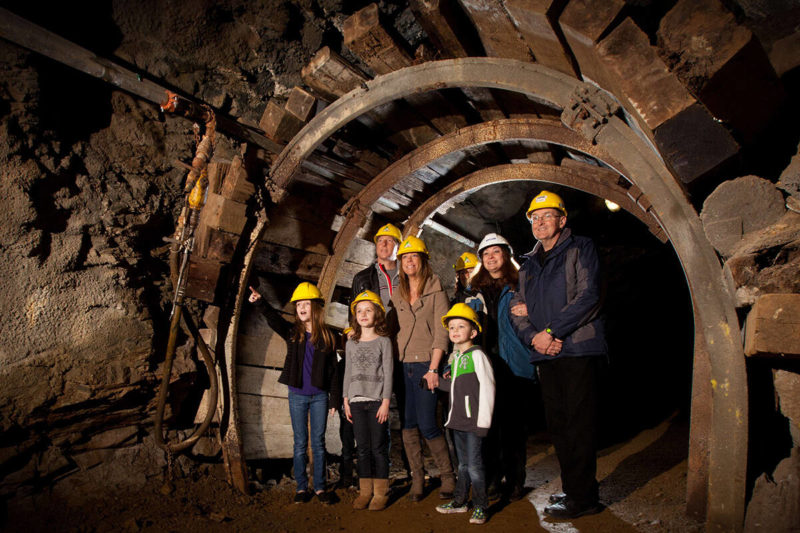As soon as humans realized they could extract stuff from the ground that could be put to use or turned into beautiful things, they’ve been digging. Many civilizations have used the spoils recovered to fashion items of value and practicality.
Fast forward to around 1760 and the industrial revolution heralded the modern age of manufacture and the search for black gold to keep it all going. Of course, BC is full of natural resources of all kinds, including a vast array of minerals and precious metals that were just waiting for discovery (At least that’s how it was viewed at the time). Right here in BC, there was lots of the black gold to be found and many a fortune was made in its mining.
All that glitters is not gold
It’s hard to ignore the allure of gold, and there was plenty of that about, and a fever to find it! BC’s population exploded with the gold rush, bringing in thousands of hopefuls who were here to strike it rich. While many of them didn’t find monetary riches, they did stick around, contributing to the growth of the province both above and below ground.
Gold fever aside, BC is rich in many other minerals, and industry needs all sorts of things from the belly of the earth to make it tick — from early steam engines to modern day computers and electric cars, many of the necessary ingredients are found underground right here.
The pride of the commonwealth
If you have a yen to actually go down a mine, then the Britannia Mine Museum, once the largest copper mine in the British Commonwealth, is a great place to start. Over the 70 years it was operational, it produced more than 50 million tons of ore that yielded copper, zinc, lead, cadmium, silver and gold.
Among the many informative exhibits, is a mine train that takes visitors into the chilly depths just like it was in 1914. Find out what it took to be a miner, or if you prefer to stay above ground, check out the other exhibits that include 17 original buildings and the immersive new Boom! exhibit which brings the mine to life with seat-rumbling special effects. One more level of caché —the mine has been used in both The X-Files and Supernatural TV shows.
Industrial history and aprés ski
The Rossland Museum presents the history and heritage of the Rossland area. It has exhibits that explore the main industry — mining — and exhibits that look at social, cultural and sports history (especially skiing!). It’s located on the site of the Le Roi Gold Mine, a mine that began with the gold rush in Rossland and was open from
Mining on a massive scale
The Bullion Pit differs a bit from the other types of mines. It’s not so much a museum as the others, but still worth a look and certainly of historical interest. Just three miles from Likely, BC, the astonishing man-made gorge that is the Bullion Pit measures over three kilometres in length and nearly a quarter kilometre wide. It was once the largest hydraulic placer mine in world, operating from 1892 to 1942.
The trail is relatively easy, although steeper in one section, and winds through the site of the Bullion Pit hydraulic mine, offering a view of the manmade canyon from the days of the gold rush. Some of the mining equipment is available to view, and a little bit of imagination helps to imagine what it might have been like in its hey day.
Morden Colliery Historic Provincial Park
The Friends of Morden Mine advocated for the funding to preserve the historical structures for future generations and in 2019, the provincial government committed $1.4 million to restore the Morden Mine headframe and tipple structure in the Morden Colliery Historic Provincial Park. The structure, built in 1912, was in danger of collapse and since it is a rare surviving example of a Vancouver Island coal mine, it was deemed worthy of preservation. Coal mining and resource extraction dominated life in the region for nearly a century, and drove non-native settlement too. These are the most complete remaining complex of coal mining surface structures on Vancouver Island and well worth a look.
READ MORE: Restoration work stabilizes Morden Mine tipple south of Nanaimo
Another island mine
Cumberland was an early coal-mining town. Today, the Cumberland Museum tells the story of the people of Cumberland with a diverse collection that explores the diverse history of the miners who came to work and the community that grew up around them. Find out about the history of labour disputes in the mining world, the history of the railway that ran between Union Bay and Cumberland, and the many businesses that served workers and settlers.
For those looking for an indoor-and-definitely-not-underground adventure, the Royal BC Museum offers a comprehensive look at the history of the province and how it came to be as it is now, which includes some great mining exhibits that bring the past to life in an indoor setting!
Plan your adventures throughout the West Coast at westcoasttraveller.com and follow us on Facebook and Instagram @thewestcoasttraveller. And for the top West Coast Travel stories of the week delivered right to your inbox, sign up for our weekly Armchair Traveller newsletter!











 Victoria flotilla welcomes M.V. Coho, cross-border travellers, for first time since March 2020
Victoria flotilla welcomes M.V. Coho, cross-border travellers, for first time since March 2020